| Botanical Name |
|
| Family |
Asphodeloideae - |
| Pronunciation |
|
| Common Name(s) |
English: Stalked bulbine; Cat's tail
Afrikaans: Geelkatstert; Kopieva; Rankkopieva; Wildekopieva
IsiXhosa: itswele lenyoka; utswelana
|
| Plant Group |
- Ground Cover A plant with a low-growing, spreading habit, grown specifically to cover the ground.
- Succulent A plant having fleshy stems or leaves often adapted to dry conditions.
|
| Plant Size |
- Small to Medium
| Tree | 8m to 15m |
| Shrub | 75cm to 1m |
| Perennial/ground cover | 20cm to 40cm |
| Bulb | 30cm to 40cm |
| Succulent | 20cm to 40cm |
|
| Position |
- Light or Dappled Shade Found below trees with sparse, open foliage. Ideal for the protection of herbaceous plants.
- Partial Shade The area is in shade for part of the day and in full sun for part of the day.
- Sun The area is in full sun for all or most of the day, all year round.
|
| General Information |
- Drought Tolerance: Moderate The plant is moderately adapted to arid conditions and can survive short periods of drought and high temperatures without extra water.
- Evergreen Plants that have leaves all year round.
- Frost: Half-hardy The plant is able to survive low temperatures and some frost but requires protection against severe frost.
- Roots Non-invasive Safe to plant near pools, paving, walls or buildings.
- Sand tolerant Plants adapted to survive in nutrient poor, very sandy soils.
- Water Wise Plant species originating from low rainfall regions that require less water to survive and thrive than other plant species.
- Wind Tolerant Plants able to withstand the effect of strong winds.
|
| Specific Information |
Bulbine frutescens has grey-green, fleshy succulent leaves, about 20 cm long, arranged in an open rosette. The plants branch rapidly and form large, wide-spreading clumps. The plants are somewhat dormant during summer, flowering in spring and autumn. It is easy to grow and needs little care. It can be used en mass for landscaping but is just as useful in the garden.
|
| Ad Break |
|
| Flowers |
| Description |
loose clusters of star-shaped blooms on the end of thin stems
|
| Season |
- Autumn Plants will seldom bloom for the entire season as given in the list, but should flower during a period within these parameters.
- Spring Plants will seldom bloom for the entire season as given in the list, but should flower during a period within these parameters.
|
| Colour |
|
| Growth Rate |
- Fast Specifying growth rate can be very misleading as there is considerable variation of growth rate depending on type and species of plant, available water, supplementary feeding, mulching and general care, as well as the plants suitability and adaptability to the garden environment.
|
| Plant Uses |
- Border A strip of ground, at the edge of a driveway or path in which ornamental plants or shrubs are planted.
- Edging A low growing plant that provides softness or definition to the edges of a bed or walkway.
- Filler Either a fast growing tree or shrub used temporarily to fill in an area while the permanent plants grow to a desired size, or a plant used to fill gaps in borders or beds.
- Ground Cover Low-lying plants that spread fast, require minimal maintenance, and cover large expanses or bare areas between bulbs or shrubs. They provide protection from erosion and drought and improve the visual appearance of the garden.
- Mass Planting Plants useful for filling a large area with just one or a few kinds of plants spaced close together. Creates a bold, dramatic effect and to reduces maintenance.
- Pioneer for new gardens A very fast growing plant, able to withstand hardship, that can be used to populate land that has recently been cleared of natural vegetation. These plants pave the way for slower-growing species by adding nutrients to the soil and creating leaf litter.
- Rock Garden An area constructed of larger rocks, arranged naturally, to emphasise the use of stones as a main element. Generally plants used do not need a lot of care.
- Stabilize Banks Plant is used to prevent soil erosion because their roots will form a mat that stabilizes the soil and keeps it from washing away in heavy rains.
- Suitable for coastal gardens Plants adapted to dry, sandy soil, forceful wind, limited rainfall and intense sunlight.
- Wild Garden An indigenous garden planted for the benefit of wildlife and birds. Provides food, water, a variety of mini-biomes and no poisonous chemicals are used.
|
| Distribution and Habitat |
in all the provinces of South Africa as well as in Lesotho and Swaziland, the greatest concentration being in the dry valleys of the Eastern Cape
|
| Planting Suggestions |
Plant Bulbine frutescens in well-drained soil, preferably enriched with compost. These plants make an exceptional show when the yellow and orange varieties are planted interspersed with one another and it combines beautifully with blue dwarf agapanthus, which flowers at the same time. Prune it when untidy, remove old flowers before to lengthen the flowering period and remove frost or drought damaged foliage. The easiest methods of propagation are by clump division or cuttings. Choose cuttings that already have adventitious roots attached. These can be planted directly where they are needed or rooted in a shady bed. Keep moist but not wet and they should develop a good root system within two months.
|
| Medicinal Uses |
The fresh leaf produces a jelly-like juice that is wonderful for burns, rashes, blisters, insect bites, cracked lips, acne, cold sores, fever blisters, mouth ulcers, pimples, insects stings and bites, and areas of cracked skin. It can also be used for sores and rashes on animals. A soothing drink can be made for coughs, colds and arthritis by preparing an infusion of a few fresh leaves in a cup of boiling water, which is strained before drinking.
|
| Ad Break |
|


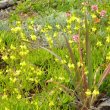

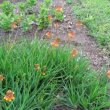
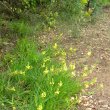
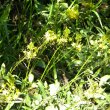
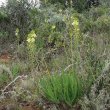


Comments
Bulbine frutescens
What is the best method to control the spreading of this plant. We had to leave our home for 2 years and when we came back, it had taken over. We plan on pulling out alot of it, but how can we control it from here on in? We are seniors and are trying to cut back on the amount of yard work. Thanks,
M
Bulbine frutescens invasion
Hi Marcia
Oh dear, that is a nuisance. To prevent the plants from spreading I ruthlessly remove any plants growing beyond the boundaries I have set for them. To prevent my plants from spreading seed I use hedge shears to cut back the unripe seeding heads en mass, before they have a chance to ripen. This means cutting off the last of the flowering heads as well but it does keep the seeds from spreading. The cut heads should be burnt or removed from the property or they will ripen and drop seed wherever they lie.
Be warned that where you remove existing plants, a great number of seeds are lying in wait. I removed a bed of these bulbines about a year ago as I needed the space. Since then I have had to deal with an everlasting eruption of seedling plants and these I just have to hand pull - luckily the root systems are quite shallow.
For myself I would be tempted to eradicate all the existing mature plants and start fresh by transplanting the seedlings that come up, to the area I want them to grow.
I am sorry I can't be of more help with your problem.
Kind regards
Lorraine
Discuss this plant
Share knowledge, ask a question or give an experience.